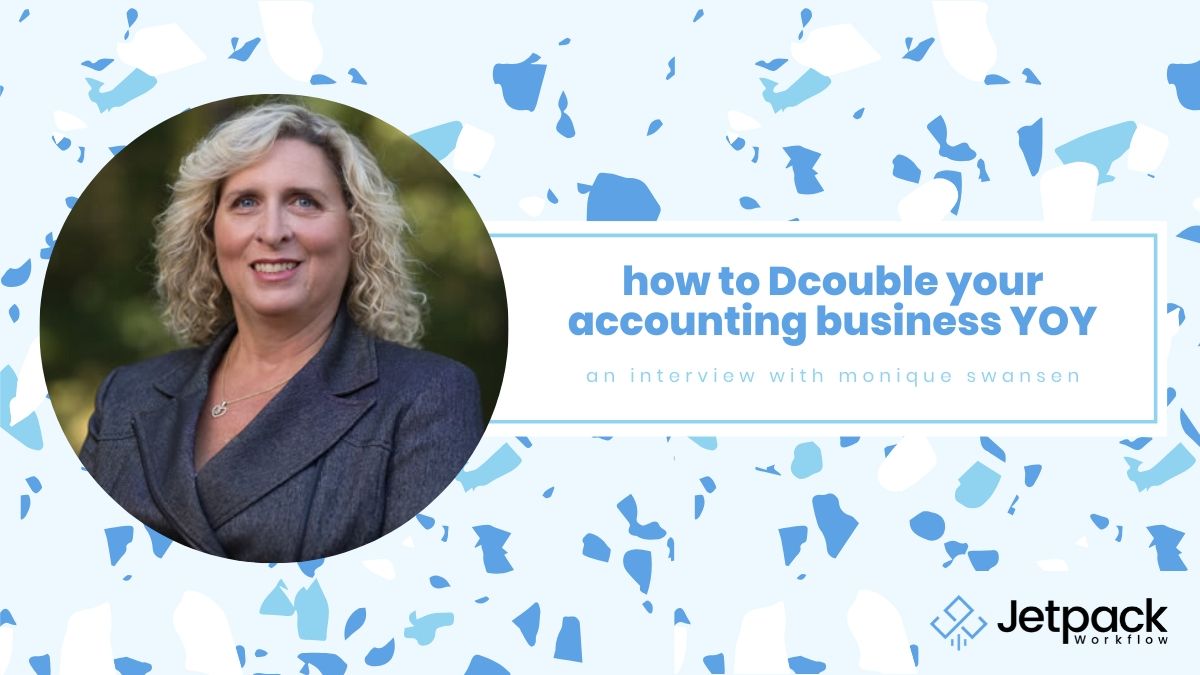How To Double your Accounting Business YOY

This week, Growing Your Firm is staying true to its name and asking one firm owner how she grew her firm from a solo bookkeeping service to a thriving six-person team. Monique Swansen is the head of Automated Accounting Services, located in Merrimac, Massachusetts.
In this podcast, we talk about how she’s been able to double her business every year for the past five years without losing her clients or her mind. We touch on issues about technology, hiring, client relations, and much more. If you’re a small firm owner, grab a pen to take some notes and take a listen. We think you’ll enjoy this case study.
Thanks again to Monique for taking the time to talk with us.
In this episode of the Growing Your Firm Podcast, David Cristello and Monique Swansen discuss:
- How moving to a cloud-based system tripled Monique’s billable hours.
- How she got her clients to move away from the manual system
- Trusting your gut when hiring
- Dividing labor among your staff smartly
- Keeping in touch with clients after you step away
- And more!
Additional Links:
Monique’s siteMonique’s LinkeIn Profile
How Automated Accounting Services Scaled Successfully
I started my firm in 2009 after breaking my relationship with a former business partner. I took some of the smaller bookkeeping clients and created an outsourced onsite bookkeeping firm. Given the economic downturn, this wasn’t the best time to be starting a business but I felt with my existing relationships I would be able to weather the storm.
It was great being a solopreneur, but as the years passed I wanted to grow into something bigger. I made that decision in 2013 when I decided to convert my company from an onsite desktop model to a cloud-based model using QuickBooks Online and the apps in that ecosystem.
Since then, I’ve doubled the business every year at a minimum. It’s been unbelievable. And I want to share with the Jetpack audience some of the challenges and techniques I used to make it possible.
First Steps
The first thing I had to do, after learning the software, was to make a decision that all new clients would use the remote solution. My new clients didn’t have much trouble with this. The problem was with converting my old clients to the new solution. This was a major pain point. I had to convince them that moving to this new system wasn’t going to make their bookkeeping fall apart.
I caught a lucky break. A client of mine was moving far enough away that it wasn’t going to be easy to get to them and they became my Guinea pig. Once we got a system that worked well for both of us, I could turn to my other existing clients and say “Look, here’s my old client and we’ve successfully transitioned, and these new clients are jumping on board with no problems. You can stop worrying.” And they did and I stopped driving around everywhere to pick up receipts.
This tactic of getting a smaller portion of your client base to act as an early adopter to bring the rest of your base along is a powerful one. Maybe you do hourly pricing and want to move to fixed pricing. If you can get 1-3 clients on your side there, it’s much easier to get others to come along by using them as a case study.
Freeing Up Time
Getting everyone onto the cloud-based system freed up a lot of time for me. I was able to do so much more work in a shorter amount of time. Once I got my workflow locked in, I could bring on more clients and feel more comfortable about onboarding them. Driving from client to client is so risky, especially if you have more than one in a day because all it takes is one appointment to run a little long and it throws everything out of whack.
Now that the remote solution was working I could literally do three times as much work as I used to in a day. I also had the time to start taking on special projects and cleanup work during the work week rather than doing it over the weekends. So getting everyone onto the remote solution allowed me to scale up to a new level right away.
I was already turning away business from referrals because I didn’t have enough time before I moved to the cloud. It was wonderful to go back to them and tell them that I could take on their business.
First Hire
One thing I should have done far sooner than I did was bring on my first hire. I did it about 2.5 years ago and I should have done it two years prior to that. Technology enabled me to juggle 40 clients, but I reached a point again where, even with technology, a little delay in a client’s work would cause my day to get reshuffled. This was really apparent at the end of the year when I was helping my clients get their documentation ready for taxes.
And there was fear wrapped up in the decision. I worried I wouldn’t have enough time to find an employee or have enough time to train them. But once I bit the bullet things go so much easier. At this point, I wasn’t worried about paying for the hire. It was a time worry and a trust issue as well. I had anxiety about showing someone else my client’s books. Would the clients be okay with it? Will they wonder if the hire will screw up or not? I had a sticking point about giving away control when I really needed to let go and trust my gut.
Don’t kick the hiring can down the road because you think you’re too busy already. With each new hire, I’ve been able to reach another level of scaling. I now have a team of six workers, two full-time and four part-time. We’re all remote and do bi-weekly meetings on Zoom and also use Slack for day-to-day communication and continuing education. Without my team, I would not be able to have achieved the growth levels I’ve experienced in the past few years.
Growing Pains
One thing that did take me some time to build was my onboarding process. We had a team member that didn’t work out with us because they had never really worked remotely before. They were used to an office environment. Anyone who hasn’t worked from home for an extended period of time doesn’t know how isolating it can be. Some people get too distracted by what’s around them at home and their work suffers.
So when we had the exit interview, I made sure to ask them what I could have done better or if there were things that I could have explained better about expectations or about the environment. And it was through failure experiences like these that I got the most growth in improving my workflows and processes.
If you listen to the rest of the podcast, you can learn more about how I screen new hires, how I allocate them to our clients and how I stay in the loop with them throughout the year to see what services they need. It’s been an exciting ride and we’re growing quickly by word of mouth alone. One of my challenges this year is to get the sales and marketing piece in place!
RELATED ARTICLES:





